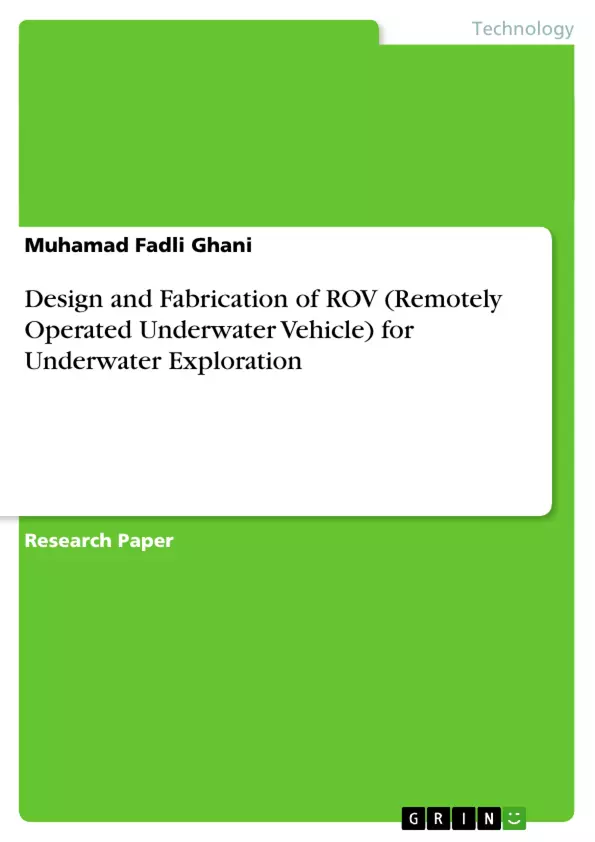This paper presents a design and fabrication of a remotely operated vehicle (ROV) for underwater exploration. Underwater vehicles are classified in two main groups as manned underwater vehicles (MUVs) and unmanned underwater vehicles (UUVs). Today, because of high operational costs, operator weariness and the painful experiences in history, which gave rise to the improvements in the UUVs, employment of the MUVs are highly limited. From operational aspects, UUVs are grouped in two main
categories as remotely operated vehicles (ROVS) and autonomous underwater vehicles (AUVs).
Introduction
Due to technology improvements obtained in the last decades, it is possible to use robotic vehicles for underwater exploration. This vehicle is called ROV (Remotely Operated underwater Vehicle) and has been substituting for divers in accomplishment of task that may result in risks to human life. ROVs also used thoroughly in the research of subsea phenomena and in the assembly, inspection and repair of offshore structures [1].
ROVs are powered by electric current and it is transported by wires in a long cable, called a tether or umbilical that connects the underwater robot with its power source. ROVs are directly controlled by a pilot who is usually stationed on a ship or on shore while the vehicle is underwater doing some sort of work. The pilot’s control system is linked to the ROV by the same tether. It provides an electrical part for control and video signals to travel between the control box and the robot. If a camera is mounted on the ROV, it will enables the pilot to alert what the robot is encountering underwater and thus effectively navigate and control the robot movement [2].
Problem Statement
In many active areas in marine engineering there is a need to use unmanned underwater robotic vehicles (UUVs) with improved ability and increasingly autonomous or independent behaviour in order to lower cost and increase safety and reliability of missions or works. UUVs can be classified into two main categories which are remotely operated underwater vehicles (ROVs) and autonomous underwater vehicles (AUVs).
The use of these vehicles is quickly growing as they can operate in deeper and riskier areas where divers cannot reach. Usual applications which include both commercial and military activities as well as scientific research are inspection and structural evaluation of submersed installations, transportation and assembly of underwater structures, ship rescue, mine hunting, geotechnical and environment data gathering, dump or toxic waste location and many others. Therefore, it is highly desirable to design and fabricate an ROV for underwater exploration.
Objective of the Research
The main objective is to focuses on the issues of design and fabrication development of an ROV. The factors that affect the ROV performance will be identify by experimental verification and trials.
Scope of the Research
The scope of this research is more focus on:
i) The mechanical construction of ballast tank for buoyancy system.
ii) The chassis fabrication using aluminium.
iii) The electrical system for monitoring and controlling the ROV.
Materials and Methodology
i) Material
The material will be used in this research were the chassis of ROV made from aluminium and using some electronic components. The propeller made from alloy-copper material.
ii) Research Process Phase
The flowchart shows the research process for this project. First step is problem identification or problem statement, then reviewing information or literature review. Next process is data collection and analysis. The last step of the project research process is making the conclusion.
Frequently Asked Questions
What is the purpose of Remotely Operated Vehicles (ROVs)?
ROVs are robotic vehicles used for underwater exploration. They are powered by electricity and controlled remotely by a pilot, often from a ship or shore. ROVs are used in tasks that may be risky for human divers and for research purposes.
What are the applications of ROVs?
ROVs are used in a wide range of applications, including the inspection and evaluation of submerged installations, transportation and assembly of underwater structures, ship rescue, mine hunting, geotechnical and environmental data gathering, and locating dumps or toxic waste.
What are the two main categories of Underwater Vehicles?
Underwater vehicles can be classified into two main categories: Remotely Operated Vehicles (ROVs) and Autonomous Underwater Vehicles (AUVs).
What is the main objective of this research?
The main objective of this research is to focus on the design and fabrication development of an ROV. The research will also identify factors that affect ROV performance through experimental verification and trials.
What is the scope of this research?
The scope of the research focuses on: (i) the mechanical construction of the ballast tank for the buoyancy system, (ii) the chassis fabrication using aluminum, and (iii) the electrical system for monitoring and controlling the ROV.
What materials are used in the ROV construction?
The chassis of the ROV is made from aluminum, and some electronic components are used. The propeller is made from alloy-copper material.
What are the phases of the research process?
The research process consists of: (1) problem identification/problem statement, (2) reviewing information/literature review, (3) data collection and analysis, and (4) making conclusions. The project is divided into three phases: (1) starting the research, choosing the general topic, narrowing the topic, and collecting information, (2) recording information, organizing ideas, and analyzing, and (3) writing, documentation, and presentation.
- Arbeit zitieren
- Muhamad Fadli Ghani (Autor:in), 2012, Design and Fabrication of ROV (Remotely Operated Underwater Vehicle) for Underwater Exploration, München, GRIN Verlag, https://www.hausarbeiten.de/document/189476


